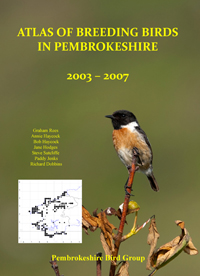Feral Pigeon/Rock Dove - 1994
 Thursday, December 22, 2011 at 5:25PM
Thursday, December 22, 2011 at 5:25PM Breeding resident
Mathew (1894) noted Rock Doves at Ramsey, Elegug Stacks and Huntsman's Leap but by 1949 Lockley et al. thought that they were "perhaps extinct as a pure race".
Feral Pigeons (wild populations of birds descended from domesticated stock) now breed all around the outer coastline, showing a great variety of plumage patterns some of which closely approach that of Rock Doves. They also breed in town buildings, castles and ruins, industrial sites and country churches. Some farms still have breeding birds in the pigeon-holes of the barns, presumably descendants of stock that was once kept for winter meat.
Pigeon fanciers operate many lofts within the county and their birds can frequently be seen flying around in flocks that act cohesively whereas Feral Pigeons generally act much more as individuals. Drop-outs from pigeon races occur on the offshore islands as far out as the Smalls and undoubtedly keep the feral mainland population topped up.
An average of two pairs of Feral Pigeons per tetrad are estimated to breed around the outer coastline. A further broad estimate of 40 pairs per tetrad elsewhere suggests a minimum Pembrokeshire breeding total of about 3,000 pairs.

Fieldwork 1984-88 (based on 478 tetrads)
Red = breeding confirmed = 60
Orange = breeding probable = 17
Yellow = breeding possible = 66
Total tetrads in which registered = 143 (29.9%)
 1994 BoP in
1994 BoP in  Feral Pigeon
Feral Pigeon 

Reader Comments